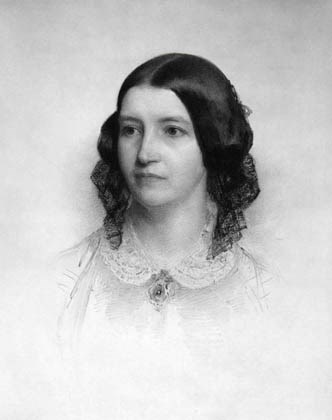
NPS Photo / Anna Christie The "Gold Ring Room" is the modern-day name for the northwest chamber, accessed from the back stairs, sharing the landing with the northeast chamber. Before the addition of the 1790s ell, this room was at the rear of the house and had two additional windows on the north wall. A door on the north wall now connects into a small bedroom in the ell. Flanking the fireplace on the south wall are small connecting rooms to the southwest chamber. 18th Century BedchamberThere is little information about this room's use until the nineteenth century. It was certainly used as a bedchamber, possibly by the Vassalls or their children. During the house's use as Washington's headquarters it may have been occupied by Jackie and Nelly Custis, Martha Washington's son and daughter-in-law, or General Horatio Gates and his wife Betsy. Mrs. Craigie and Her BoardersAfter her husband’s death in 1819, Elizabeth Craigie rented out bedchambers to a rotating cast of mostly young men – students of law and theology and professors at Harvard College. Some of those young men are known to have rented this room. Jared Sparks, biographer of George Washington, and his wife rented the west side of the house in 1834. Here, in Washington’s first headquarters, he edited The Writings of George Washington and his wife Frances gave birth to their daughter. For at least a portion of Henry Longfellow’s time as a boarder, Elizabeth Craigie used this room as her own bedroom. In 1842, Joseph Emerson Worcester, lexicographer, rented this half of the house from Craigie’s estate and later Henry Longfellow, until his house next door was completed in 1844. The Longfellows' BedroomThe Longfellows decorated this room as their master bedroom in May 1844. Fanny Longfellow's father Nathan Appleton purchased the bedroom suite of bed, armoire, and dresser from Boston cabinetmaker George Archbald as a wedding present for the couple. The gold ring on the ceiling, likewise a gift from Appleton, was used for bed hangings, and gave the room the name "wedding ring room" or "gold ring room." In the Longfellows' time, the room was probably green. A door next to the bed (later removed) connected to Henry's dressing room in the ell.
Fanny Longfellow wrote to her stepmother on May 8, 1844, "The carpet is making today in my bed-room & I hope to move into it this week. I am impatient to have the other rooms in order, but dare not venture upon any paint so near a certain event." The impending "event" was the birth of her first child, who arrived a month later on June 9th. He, like most of the couple's six children, was born in this room. Fanny wrote of her second child at about two months old, "...he is more constantly with me by night as well as day. He sleeps by my bedside in his little crib, & is so quiet & good that the touch of my finger is sufficient to rock him gently asleep after each meal." 
NPS Photo Here in This Room She DiedFanny Longfellow died here on 10 July 1861 from burns sustained in an accidental fire. Her husband outlived her by 21 years and carried grief with him the rest of his life. The drawing of Fanny Longfellow by Rowse was hung above the fireplace after her death, and is referenced in Henry Longfellow's 1879 sonnet "The Cross of Snow":
|
Last updated: February 2, 2022
